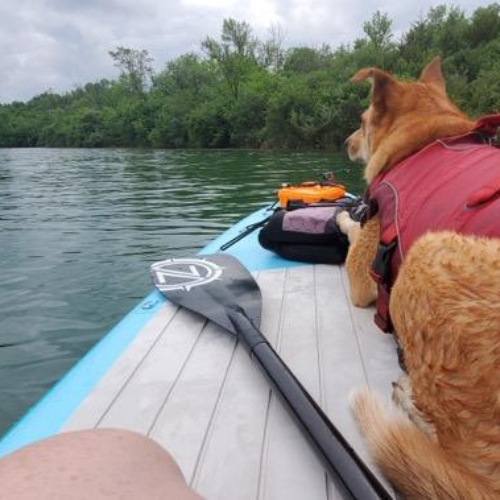Iowa Water Watchdogs
 We love taking our canine companions on adventures to Iowa’s parks, lakes, and streams. Dog caretakers know there are risks in natural environments that they have to be aware of when they take their dog out. A lesser-known risk is cyanotoxin poisoning from a harmful algae bloom (HAB) in a natural waterway.
We love taking our canine companions on adventures to Iowa’s parks, lakes, and streams. Dog caretakers know there are risks in natural environments that they have to be aware of when they take their dog out. A lesser-known risk is cyanotoxin poisoning from a harmful algae bloom (HAB) in a natural waterway.
What are the dangers to dogs?
.jpg) HABs can produce cyanotoxins such as microcystins or anatoxins that can cause a number of health issues in humans and animals that come into contact with the water. Unfortunately, dogs are especially at risk of lethal cyanotoxin poisoning because of their behaviors in the water, including swimming, drinking, and licking water or scum from their fur after swimming. Only a small amount of ingested cyanotoxin can lead to health issues in dogs, and in the worst cases, coma or death. Symptoms can appear within minutes or hours.
HABs can produce cyanotoxins such as microcystins or anatoxins that can cause a number of health issues in humans and animals that come into contact with the water. Unfortunately, dogs are especially at risk of lethal cyanotoxin poisoning because of their behaviors in the water, including swimming, drinking, and licking water or scum from their fur after swimming. Only a small amount of ingested cyanotoxin can lead to health issues in dogs, and in the worst cases, coma or death. Symptoms can appear within minutes or hours.
.png) Iowa Water Watchdogs is a special campaign of Iowa Water Watch to raise awareness about the risks of cyanotoxin poisoning in dogs. We want all dogs and their caretakers to be safe in Iowa’s lakes and streams. Follow the tips below to keep your dog safe at natural waterways!
Iowa Water Watchdogs is a special campaign of Iowa Water Watch to raise awareness about the risks of cyanotoxin poisoning in dogs. We want all dogs and their caretakers to be safe in Iowa’s lakes and streams. Follow the tips below to keep your dog safe at natural waterways!
- Avoid water that appears scummy, smells bad, or has paint-like streaks. View our photo gallery to see what toxic algae looks like.
- Supervise your dog at all times. Do not let your dog eat algal scum or lick scum off its fur.
- Wash dogs off with clean water immediately after swimming.
- Provide clean water from the tap for drinking. Do not give your dog lake, river, or pond water to drink.
- Check signage at the beach for any advisories or water quality notices.
- Check IEC's Weekly Water Watch from Memorial Day weekend through Labor Day weekend for beach advisories.
 You cannot tell by sight if a bloom is toxic. If you are unsure if the algae in the water is an HAB, do not allow your dog to drink from or enter the water. When in doubt, stay out!
You cannot tell by sight if a bloom is toxic. If you are unsure if the algae in the water is an HAB, do not allow your dog to drink from or enter the water. When in doubt, stay out!
If your dog begins exhibiting any symptoms of cyanotoxin poisoning, take them to the vet right away:
- diarrhea or vomiting
- disorientation, staggering
- jaundice
- malaise or extreme tiredness
- weakness
- difficulty breathing
- muscle tremors, convulsions, seizures, or paralysis
- excessive salivation or foaming at the mouth
- blood in urine or dark urine
Check out our factsheet for more information!

Sign up for Weekly Water Watch for updates on HABs
IEC posts water quality and beach advisory information, including HABs, every Friday from Memorial Day to Labor Day on our website. We also send our Weekly Water Watch email each Friday with the alert information. Sign up here to be added to the Weekly Water Watch list!
Is your dog an Iowa Water Watchdog?
Iowa Water Watchdogs are safe in Iowa’s natural waterways! Help us to raise awareness to protect our Water Watchdog friends and others who recreate in Iowa's waters.
We also invite you to share your photos of your Water Watchdog with us by tagging us on our Iowa Water Watch Instagram account (@iowawaterwatch) with the tag #iowawaterwatchdog. You can also send them to us at iecmail@iaenvironment.org and we might feature your pup on our website or in an upcoming Water Watch newsletter!
Sources: Centers for Disease Control, Wisconsin Department of Health Services, American Kennel Club